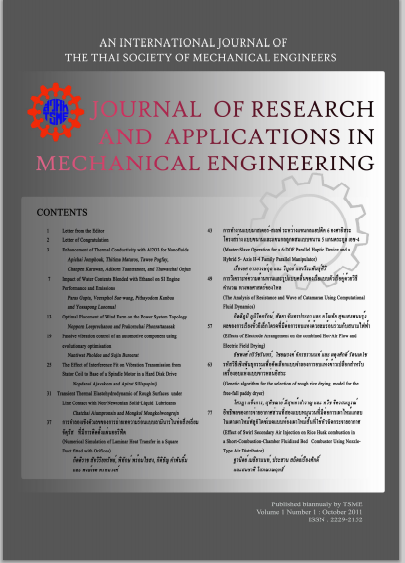Numerical simulation of laminar heat transfer in a square duct fitted with orifices
Main Article Content
Abstract
Laminar periodic flow and heat transfer in a three dimensional square channel with isothermal walls and with =30o orifice baffle; (diameter ratio (d/D), DR) in range from 0.5 to 0.8 and (Pitch ratio, PR) of 1.5 is investigated numerically. The computations based on the finite volume method, and the SIMPLE algorithm has been implemented. The fluid flow and heat transfer characteristics are presented for Reynolds numbers based on the hydraulic diameter of the square channel ranging from 100 to 1200. Effects of orifice baffle on heat transfer and pressure loss in the square channel are studied. It is found that the orifice baffle performs better than the smooth square channel for all Reynolds number values. The decrease of the DR leads to an increase in the Nusselt number and friction factor. The computational results reveal that the DR of 0.5 provided the highest on both heat transfer and friction factor.
Article Details
This work is licensed under a Creative Commons Attribution-NonCommercial-ShareAlike 4.0 International License.
References
[2] Ridouane, E.H., Campo, A., 2008. Heat transfer enhancement of air flowing across grooved channels:joint effects of channel height and groove depth. ASME J. Heat Transfer , Vol. 130, No.2,
[3] Chompookham, T., Thianpong, C., Kwankaomeng, S., Promvonge, P., 2010. Heat transfer augmentation in a wedge-ribbed channel using winglet vortex generators. Int. Commun. Heat Mass Transfer, Vol. 37, No. 2, pp. 163-169.
[4] Sripattanapipat, S., Promvonge, P, 2009. Numerical analysis of laminar heat transfer in a channel with diamond-shaped baffles. Int. Commun. Heat Mass Transfer, Vol. 36, No. 1, pp. 32-38.
[5] Han, J.C., Zhang, Y.M., Lee, C.P., 1991. Augmented heat transfer in square channels with parallel. crossed and V-shaped angled ribs. ASME J. Heat Transfer, Vol. 113, pp. 590–596.
[6] Han, J.C., Zhang, Y.M., Lee, C.P., 1992. Influence of surface heat flux ratio on heat transfer augmentation in square channels with parallel, crossed, and V-shaped angled ribs. ASME J. Turbomachinery, Vol. 114, pp. 872–880.
[7] Murata, A., Mochizuki, S., 2001. Comparison between laminar and turbulent heat transfer in a stationary square duct with transverse or angled rib turbulators. Int. J. Heat Mass Transfer, Vol. 44, pp.1127–1141.
[8] Hans, V.S., Saini, R.P., Saini, J.S., 2009. Performance of artificially roughened solar air heaters–A review. Renewable and Sustainable Energy Reviews, Vol. 13, pp. 1854–1869.
[9] Varun, Saini., R.P., Singal, S.K,. 2007. A review on roughness geometry used in solar air heaters. Solar Energy, Vol. 81, pp. 1340–1350.
[10] Patankar, S.V., Liu, C.H., Sparrow, E.M., 1977. Fully developed flow and heat transfer in ducts having streamwiseperiodic variations of cross-sectional area. ASME J. Heat Transfer, Vol. 99, pp. 180-186.
[11] Berner, C., Durst, F., McEligot, D.M., 1984. Flow around baffles. Trans. ASME J. Heat Transfer, Vol. 106, pp. 743–749.
[12] Webb, B.W., Ramadhyani, S., 1985. Conjugate heat transfer in a channel with staggered ribs. Int. J. Heat Mass Transfer, Vol. 28, pp. 1679–1687.
[13] Kelkar, K.M., Patankar, S.V., 1987. Numerical prediction of flow and heat transfer in a parallel plate channel with staggered fins. ASME J. Heat Transfer, Vol. 109, pp. 25–30.
[14] Lopez, J.R., Anand, N.K., Fletcher, L.S., 1996. Heat transfer in a three-dimensional channel with baffles. Numerical Heat Transfer, Part A: Applications, Vol. 30, pp. 189–205.
[15] Guo, Z., Anand, N.K., 1997. Three-dimensional heat transfer in a channel with a baffle in the entrance region. Numerical Heat Transfer, Part A: Applications, Vol. 31, No. 1, pp. 21-35.
[16] Patankar, S.V., 1980. Numerical Heat Transfer and Fluid Flow. McGraw-Hill, New York.
[17] Incropera, F., Dewitt, P.D., 1996. Introduction to heat transfer. 3rd edition John Wiley & Sons Inc.



